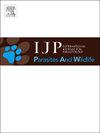侵染棘鲈鳃的两种黏液动物寄生虫的形态和系统发育比较:巨棘鲈和克雷普里鲈
IF 2.2
3区 医学
Q3 ECOLOGY
International Journal for Parasitology-Parasites and Wildlife
Pub Date : 2025-05-26
DOI:10.1016/j.ijppaw.2025.101087
引用次数: 0
摘要
据报道,巨型亨尼古雅和克雷普里尼亨尼古雅是感染猪鳃的孢子形成疟原虫。然而,根据文献记载,后者具有更广泛的宿主范围。在两种亨内古雅虫之间观察到一些显著的差异:疟原虫的形状和大小以及尾肢的长度。到目前为止,还没有提供关于H. gigantea的分子证据;而对于H. creplini,则采用18S rDNA进行分类。本研究通过形态学和分子分析资料,阐明了从棘鲈鳃中采集的H. gigantea和H. creplini的亲缘关系。在形态学上,巨芽胞杆菌形成了一簇形成疟原虫的囊体,而克雷普利尼芽胞杆菌则多为小的疟原虫。两种黏液孢子的黏液孢子的尾端附属物长度可以区分为:H. gigantea比H. creplini长(77 ~ 100 μm比14.4 ~ 40.1 μm)。其余孢子性状在两种中相似。18S和28S rDNA序列序列距离较低,分别≤0.76%和0.97%。本研究中提出的数据,结合从以前的文献中收集的数据,表明尾肢可能在物种内表现出表型可塑性,这在包括Henneguya属的新成员之前必须考虑。此外,核糖体DNA序列作为参考黏液动物的分类分类的重要工具,表现出表型可塑性。我们建议将H. gigantea重新分类为H. creplini。本文章由计算机程序翻译,如有差异,请以英文原文为准。

Morphological and phylogenetic comparison of two myxozoan parasites infecting the gills of pikeperch (Sander lucioperca L.): Henneguya gigantea and Henneguya creplini
Henneguya gigantea and Henneguya creplini have been reported as spore-forming plasmodia infecting the gills of pikeperch. However, the latter has been documented to have a broader host range. Some remarkable differences have been observed between both Henneguya species: the shape and size of plasmodia and the length of their caudal appendages. To date, no molecular evidence has been provided for H. gigantea; while for H. creplini, the 18S rDNA has been applied for its classification. In this study, we analysed morphological and molecular data to elucidate the relationship of H. gigantea and H. creplini collected from the gills of the pikeperch. Morphologically, H. gigantea resulted in a cluster of plasmodia-forming cyst bodies, while H. creplini have been mostly reported as small plasmodia. The myxospores of the two species were distinguished by the length of their caudal appendages, which were longer in H. gigantea than in H. creplini (77–100 vs 14.4–40.1 μm). The rest of the spore characters are similar in both species. The 18S and 28S rDNA sequences show low sequence distance ≤0.76 % and 0.97 %, respectively. The data presented in this study, in conjunction with those collected from previous literature, suggests that caudal appendages may exhibit phenotypic plasticity within species, which must be considered before including new members of the Henneguya genus. Furthermore, ribosomal DNA sequences serve as an essential tool for referring the taxonomic classification of myxozoans that exhibit phenotypic plasticity. We propose that H. gigantea be reclassified as H. creplini.
求助全文
通过发布文献求助,成功后即可免费获取论文全文。
去求助
来源期刊

International Journal for Parasitology-Parasites and Wildlife
Medicine-Infectious Diseases
CiteScore
3.80
自引率
5.60%
发文量
113
审稿时长
45 days
期刊介绍:
The International Journal for Parasitology: Parasites and Wildlife (IJP-PAW) publishes the results of original research on parasites of all wildlife, invertebrate and vertebrate. This includes free-ranging, wild populations, as well as captive wildlife, semi-domesticated species (e.g. reindeer) and farmed populations of recently domesticated or wild-captured species (e.g. cultured fishes). Articles on all aspects of wildlife parasitology are welcomed including taxonomy, biodiversity and distribution, ecology and epidemiology, population biology and host-parasite relationships. The impact of parasites on the health and conservation of wildlife is seen as an important area covered by the journal especially the potential role of environmental factors, for example climate. Also important to the journal is ''one health'' and the nature of interactions between wildlife, people and domestic animals, including disease emergence and zoonoses.
 求助内容:
求助内容: 应助结果提醒方式:
应助结果提醒方式:


